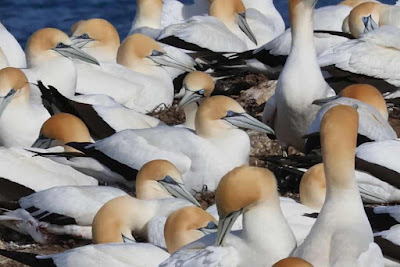Cape Nelson, the Port and Gannets
Our morning walk started up the street to the Botanic Gardens. As we entered we noticed this sign, which was a tad surprising in the middle of the town!
Even more surprising was a second copy beside this canal on the edge of the gardens. We were later told by the Gannet Guide that this is where Sammy often hangs out, showing great agility as he munches salmon that have also swum up the canal. He has been coming annually for about 3 years: the seal which got publicity earlier in the year was Neal the Seal in Tasmania.
The big news of the day was that as we emerged from the Gardens, Frances spotted a Rufous Bristlebird. I was hoping for that even more than the Cape Gannet, as the Bristlebird was a lifer: my first for 2024!
After breakfast we headed off towards Cape Nelson with scenery and walking in mind. No rain was forecast and none was showing on the radar. This was not Scotch mist on the windscreen!
When the deluge stopped we saw a burnt out turbine.An ABC report includes a photo of the incident - the turbine has gone and the third blade well alight.My initial thought was to agree with the comment by a Fire Rescue Victoria commander, quoted in the report:
"...due to the infrequency of these types of blazes, wind turbines did not pose an excessive fire risk."
However the report goes on:
"The last reported turbine fire in Portland and the surrounding region was in August 2023, when a wind turbine caught alight at the Yambuk wind farm, west of Port Fairy."
So that is one a year in a quite small area. Much higher incidence than I would have thought. An article about another fire is full of motherhood position statements but little information. I have asked for further information from a variety of sources.
We stopped at a lookout showing the bedding of the geology, with basalt on the bottom and ...
... my guess from the caves, limestone higher up.This is a eBird track of our walk from the Cape Nelson Rd to the sea cliffs.
The top of the sea cliffs was very exposed to the salt-laden winds. Thus the vegetation was both low and battered.
Sea, and also cliffs.
Two views of a Yellow Admiral on a grass-tree spike.
In the afternoon I went for a prowl around the harbour area in the Mazda.
The Silver Gulls were nesting towards the Chip Mill with some chicks walking around and other adults still sitting in nests.
A mural by ramps from the Harbour to the town.
I thought this approach to unloading the trucks full of wood chips most impressive. I am unsure if the driver is still in the cab at this stage. I would imagine that if so, he is not constipated (particularly the first time).
A toy on a pile of chips.Handling the chips: I think this mass of machinery is interesting as an image to look at. Note the stream of chips emerging from a spout at the centre back. This operation is one that I cannot image designing, but makes me recall a miner talking about taking 6 months to draft the plan for an underground blast.
I drove out on the Lee Breakwater (largely because one could) which was well populated with fisherpersons

A very large gull was a Kelp Gull: note relatively modest bill and red only on lower mandible. The guide (Josh) at the Gannet Colony commented that Kelp Gulls make up 70% of the larger gulls whereas at Mallacoota they are very uncommon - about 1% - with the rest being Pacific Gulls.
Called in at Sammy the Seal again.
Yayyyyyy! Cape Gannet. Only one in Australia! Note pale iris, amount of black around and behind eye, and gular stripe.
Comparison with Australasian Gannet on right.
The Cape Gannet is in this image. Which one?
It is right in the centre: the gular strip can be seen.



























Comments
Post a Comment